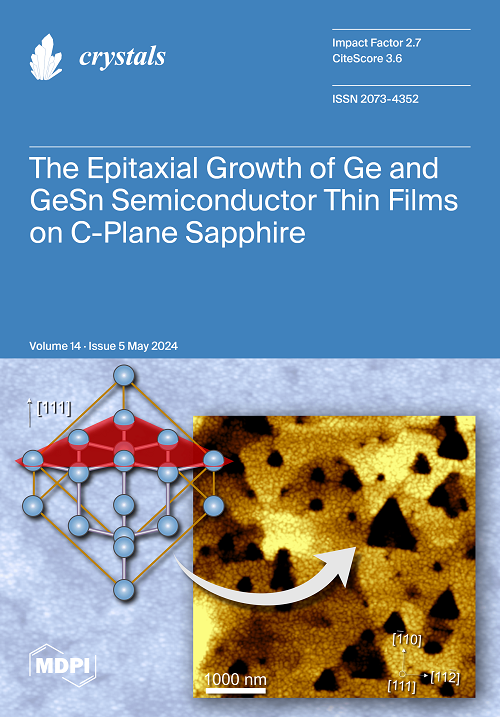商用几层石墨烯对聚烯烃混合物导电性、机械增强性和抗光降解性的影响
IF 2.4
4区 材料科学
Q2 CRYSTALLOGRAPHY
引用次数: 0
摘要
这项工作展示了市售几层石墨烯(FLG)在增强聚烯烃共混复合材料的电耗散性能、机械强度和紫外线防护方面的潜力;这些都是电子包装材料的有趣特性。聚乙烯(PE)/聚丙烯(PP)/FLG 共混复合材料的制备分为两个步骤。首先,将不同浓度的 FLG 与 PE 或 PP 相混合。随后,在第二步中,将这种预混合物与共混物的另一相进行熔融混合。从导电性、剪切诱导变形时的形态演变、机械性能和聚烯烃共混复合材料的紫外线稳定性等方面对填充了 FLG 的复合材料进行了表征。研究发现,在 PE/PP/FLG 共混复合材料中,FLG 与 PP 相的预混合是获得较高导电率的较佳混合策略。这一观察结果归因于 FLG 通过 PE/PP 界面从热力学较差的 PP 相迁移到有利的 PE 相的影响效应。有趣的是,在 PE/PP-60/40 (1.87 × 10-5 S/cm)和 PE/PP-20/80 (1.25 × 10-5 S/cm)混合物中,添加 4 wt.%(约 2 vol.%)和 5 wt.%(约 2.5 vol.%)的 FLG 可使导电率分别提高约 10 个数量级。此外,剪切引起的变形并没有改变填充 FLG 的复合材料的导电性,这表明复合材料中的导电 FLG 网络对这种变形具有弹性。此外,在紫外线暴露的聚烯烃复合材料中,1 wt.% 的 FLG 足以保持原有的机械性能。FLG 具有明显的紫外线稳定效果,尤其是在富含聚乙烯的混合物中,可减轻表面开裂并保持延展性。本文章由计算机程序翻译,如有差异,请以英文原文为准。
The Influence of a Commercial Few-Layer Graphene on Electrical Conductivity, Mechanical Reinforcement and Photodegradation Resistance of Polyolefin Blends
This work demonstrates the potentials of a commercially available few-layer graphene (FLG) in enhancing the electro-dissipative properties, mechanical strength, and UV protection of polyolefin blend composites; interesting features of electronic packaging materials. Polyethylene (PE)/ polypropylene (PP)/ FLG blend composites were prepared following two steps. Firstly, different concentrations of FLG were mixed with either the PE or PP phases. Subsequently, in the second step, this pre-mixture was melt-blended with the other phase of the blend. FLG-filled composites were characterized in terms of electrical conductivity, morphological evolution upon shear-induced deformation, mechanical properties, and UV stability of polyolefin blend composites. Premixing of FLG with the PP phase has been observed to be a better mixing strategy to attain higher electrical conductivity in PE/PP/FLG blend composite. This observation is attributed to the influential effect of FLG migration from a thermodynamically less favourable PP phase to a favourable PE phase via the PE/PP interface. Interestingly, the addition of 4 wt.% (~2 vol.%) and 5 wt.% (~2.5 vol.%) of FLG increased an electrical conductivity of ~10 orders of magnitude in PE/PP—60/40 (1.87 × 10−5 S/cm) and PE/PP—20/80 (1.25 × 10−5 S/cm) blends, respectively. Furthermore, shear-induced deformation did not alter the electrical conductivity of the FLG-filled composite, indicating that the conductive FLG network within the composite is resilient to such deformation. In addition, 1 wt.% FLG was observed to be sufficient to retain the original mechanical properties in UV-exposed polyolefin composites. FLG exhibited pronounced UV stabilizing effects, particularly in PE-rich blends, mitigating surface cracking and preserving ductility.
求助全文
通过发布文献求助,成功后即可免费获取论文全文。
去求助
来源期刊

Crystals
CRYSTALLOGRAPHYMATERIALS SCIENCE, MULTIDIS-MATERIALS SCIENCE, MULTIDISCIPLINARY
CiteScore
4.20
自引率
11.10%
发文量
1527
审稿时长
16.12 days
期刊介绍:
Crystals (ISSN 2073-4352) is an open access journal that covers all aspects of crystalline material research. Crystals can act as a reference, and as a publication resource, to the community. It publishes reviews, regular research articles, and short communications. Our aim is to encourage scientists to publish their experimental and theoretical results in as much detail as possible. Therefore, there is no restriction on article length. Full experimental details must be provided to enable the results to be reproduced. Crystals provides a forum for the advancement of our understanding of the nucleation, growth, processing, and characterization of crystalline materials. Their mechanical, chemical, electronic, magnetic, and optical properties, and their diverse applications, are all considered to be of importance.
 求助内容:
求助内容: 应助结果提醒方式:
应助结果提醒方式:


